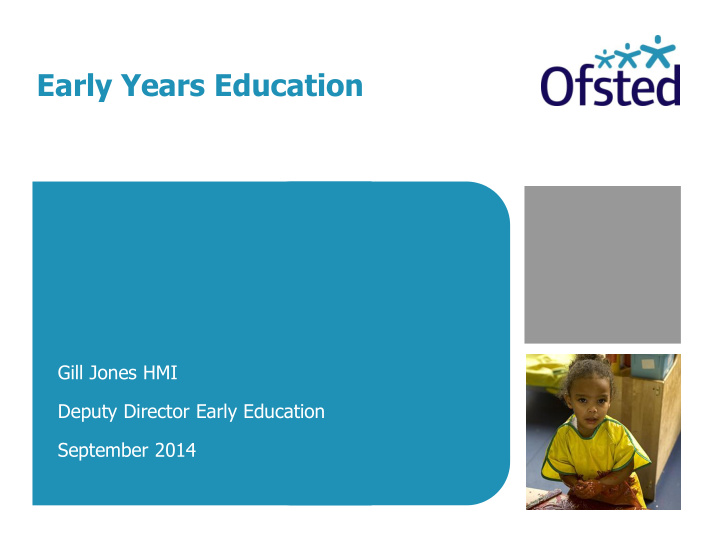



Early Years Education Gill Jones HMI Deputy Director Early Education September 2014
The Early Years Annual Report Working with the sector Changes to inspection
The Early Years Annual Report HMCI published the first dedicated early years report As a companion piece we also published a thematic report on School Readiness Traditionally Ofsted reports on Early Years have commented on the performance of Early Years Registered providers only The 2012-13 report considers all provision for ages 0-4, including schools.
The Early Years Annual Report The Chief Inspector also wrote to all Early Years inspectors The report reinforces the message that it is relevant to focus on teaching in early years The report comments on the lack of comparability between inspection judgements of EY registered providers and schools Ofsted introduced an early years judgement for schools in September 2014 which is one step towards addressing comparability .
Key messages
Key messages The report argues for a simpler, more flexible and more accountable early years system, arguing that this is necessary because: the sector is confusing for parents and too hard to access too much provision serving more disadvantaged communities is not good enough there are serious weaknesses in data and assessment, meaning it is difficult to hold providers of early education to account.
Quality continues to improve… Ofsted has contributed to this through greater rigour in registration, greater emphasis on learning and development and in our response to complaints
Outcomes have improved but the gap for the poorest children is still far too wide The report includes a league table of local authorities based on the proportion of FSM pupils reaching a good level of development in the EYFSP
Are you ready? Good practice in school readiness
Good practice; engaging parents and carers The best settings were particularly effective in working with other agencies to engage vulnerable families and target support where it was most needed Providers worked closely with parents and carers through the transition period, providing information and guidance
Good practice; engaging parents and carers Partnerships were vital in ensuring continued support for children with special educational needs and/ or disabilities as they moved from one setting to another Families were provided with a clear and well- organised programme of informal and formal meetings.
Adapting provision to children’s needs Improving children’s communication skills was a consistent feature across settings serving areas of high deprivation. Communication and language needs were carefully analysed very early in the transition period. The best settings worked with other professional agencies to ensure progress in key areas was regularly reviewed, next steps identified and to agree a common approach.
Adapting provision to children’s needs A quarter of schools reported children arriving without having their special educational needs identified and without additional support in place.
Working with the sector
Regional working Regional Director Senior HMI (EY) HMI (EY) Senior Officers Regulatory Inspectors ISPs
Driving improvement through working with the sector Setting up regional focus groups for EY representatives Listening to concerns through the ‘Big Conversation’ and other consultative forums Using local information to improve inspection and refreshing inspection provider contracts Getting to good seminars Responding to consultation outcomes Speaking at local and national events Working with a new Consultative Forum too to develop better inspection
The removal of brought forward inspections and other changes
April 2014 After listening to the sector at events like the big conversation Ofsted reviewed the risk assessment policy. Analysis showed that most of our risk assessment thresholds were accurate - priority inspections (undertaken within 5 days) often found providers to be inadequate, regional investigations often ended with enforcement action. However, analysis showed that there was little to no difference in grade profile between brought forward inspections and standard cycle inspections. Therefore providers were no more likely to be inadequate at a brought forward inspection. As a result, in April 2014, Ofsted removed the option for brought forward inspections.
Further improvements September 2014 Reporting to parents – simpler, shorter inspection reports Training for inspectors Getting to good seminars extended to include childminders Re-registration of existing providers Paid for inspections Childminder agencies Children’s centre inspection framework consultation Consultation on a common inspection framework – October 2014
Driving improvement through working with the sector Publishing films to support settings on our website: http://www.ofsted.gov.uk/resources/right-start-early- years-good-practice-films-childminders-home-reading Publishing good practice case studies on our website
Keeping the focus on children
Recommend
More recommend